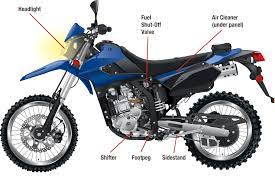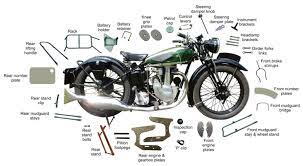
The Essential Guide to Motorbike Parts
Motorbikes are complex machines that require various components working together to ensure a smooth and safe ride. Understanding the different parts of a motorbike is essential for both riders and enthusiasts. In this article, we will explore some of the key motorbike parts and their functions.
Engine
The engine is the heart of any motorbike. It converts fuel into mechanical energy, propelling the bike forward. Motorbike engines come in various sizes and configurations, such as single-cylinder, twin-cylinder, or even larger multi-cylinder engines.
Frame
The frame provides structural support to the motorbike, holding all the other components together. It determines the bike’s size, shape, and overall stability. Frames are typically made from steel or aluminum alloy to provide strength while keeping weight to a minimum.
Suspension System
The suspension system consists of front forks and rear shocks that absorb shocks from uneven road surfaces, ensuring a comfortable ride. Good suspension allows the wheels to maintain contact with the road for better traction and handling.
Wheels and Tires
The wheels provide stability while the tires offer grip on different road surfaces. Motorbike tires come in various types, including street tires for smooth roads and off-road tires for adventurous rides on rough terrains.
Braking System
A reliable braking system is crucial for rider safety. Motorbikes typically have two types of brakes: disc brakes and drum brakes. Disc brakes offer better stopping power, while drum brakes are more common in older or smaller bikes.
Exhaust System
The exhaust system expels the gases produced during the combustion process. It plays a vital role in noise reduction and emissions control. Some riders also opt for aftermarket exhaust systems to enhance performance or create a unique sound.
Electrical System
The electrical system includes the battery, wiring, and various electrical components such as lights, indicators, and ignition systems. These components provide essential functions like lighting, starting the engine, and powering other electrical accessories.
Fuel System
The fuel system delivers fuel from the tank to the engine for combustion. It consists of components like fuel pumps, carburetors or fuel injectors, and filters. Modern bikes often use fuel injection systems for improved efficiency and performance.
Controls
The controls include handlebars, throttle, clutch lever, brake levers, and foot controls such as gear shifters and brake pedals. These components allow the rider to steer, accelerate, shift gears, and control speed effectively.
Understanding these key motorbike parts will not only help you appreciate your bike better but also enable you to make informed decisions when it comes to maintenance or upgrades. Remember that regular maintenance is crucial for optimal performance and safety on the road.
Whether you are a seasoned rider or just starting out with motorbikes, knowing your machine inside out will enhance your riding experience while ensuring your safety on every journey.
Essential Maintenance Tips for Motorcycle Longevity: A Guide to Caring for Your Bike’s Key Components
- 1. Check your motorcycle’s tyres regularly for wear and tear, and maintain the recommended tyre pressure.
- 2. Keep an eye on your motorcycle’s brake pads and replace them if they become worn down.
- 3. Regularly inspect the chain and sprockets for any signs of damage or excessive wear, and lubricate them as needed.
- 4. Ensure that your motorcycle’s lights are working properly, including headlights, indicators, and brake lights.
- 5. Maintain clean air filters to ensure optimal engine performance.
- 6. Regularly check the oil level in your motorcycle’s engine and change it according to the manufacturer’s recommendations.
- 7. Keep the battery terminals clean and free from corrosion by regularly cleaning them with a mixture of baking soda and water.
- 8. Inspect the suspension components for any leaks or damage, as well as ensuring proper adjustment to maintain stability while riding.
- 9. Pay attention to unusual noises or vibrations while riding, as they can indicate potential problems with various motorbike parts.
1. Check your motorcycle’s tyres regularly for wear and tear, and maintain the recommended tyre pressure.
Regularly checking your motorbike’s tyres for wear and tear, as well as maintaining the recommended tyre pressure, is a crucial tip for every rider. The condition of your tyres directly affects your bike’s performance and safety on the road. Worn-out or underinflated tyres can compromise traction, handling, and braking efficiency, increasing the risk of accidents. By regularly inspecting your tyres and keeping them properly inflated, you ensure optimal grip, stability, and control while riding, allowing you to enjoy a smooth and safe journey every time.
2. Keep an eye on your motorcycle’s brake pads and replace them if they become worn down.
One crucial tip for maintaining your motorbike’s safety is to regularly check and monitor the condition of your brake pads. Brake pads are a vital component that enables effective braking and control. Over time, these pads can wear down due to friction, reducing their efficiency and compromising your ability to stop quickly. It is essential to keep a close eye on your brake pads and replace them promptly if they become worn down. By doing so, you ensure optimal braking performance, enhancing both your safety and the safety of others on the road.
3. Regularly inspect the chain and sprockets for any signs of damage or excessive wear, and lubricate them as needed.
To ensure the smooth operation and longevity of your motorbike, it is crucial to regularly inspect the chain and sprockets for any signs of damage or excessive wear. These components are essential for transmitting power from the engine to the rear wheel. Over time, the chain can stretch and wear out, while the sprockets can become worn or develop teeth that are no longer sharp. By inspecting them regularly, you can identify any issues early on and take appropriate action. Additionally, lubricating the chain as needed helps reduce friction and prevents premature wear. Proper maintenance of the chain and sprockets will not only enhance your bike’s performance but also contribute to a safer and more enjoyable riding experience.
4. Ensure that your motorcycle’s lights are working properly, including headlights, indicators, and brake lights.
Ensuring that your motorcycle’s lights are working properly is crucial for both your safety and the safety of others on the road. Your headlights provide visibility during low-light conditions, allowing you to see and be seen by other motorists. Indicators play a vital role in signaling your intentions to change lanes or make turns, ensuring that other road users are aware of your movements. Additionally, functioning brake lights alert drivers behind you when you are slowing down or coming to a stop, reducing the risk of rear-end collisions. Regularly checking and maintaining these lights will help ensure that you have clear visibility and enhance your overall safety while riding your motorcycle.
5. Maintain clean air filters to ensure optimal engine performance.
To ensure optimal engine performance, it is crucial to maintain clean air filters in your motorbike. Air filters play a vital role in preventing dirt, dust, and debris from entering the engine. Over time, these particles can clog the air filter, restricting airflow and negatively impacting the engine’s performance. Regularly cleaning or replacing the air filter will help maintain proper air intake, allowing the engine to breathe freely and operate at its best. By keeping your air filters clean, you can ensure that your motorbike performs efficiently and delivers a smooth and powerful ride every time you hit the road.
6. Regularly check the oil level in your motorcycle’s engine and change it according to the manufacturer’s recommendations.
Regularly checking the oil level in your motorcycle’s engine and changing it according to the manufacturer’s recommendations is a crucial tip for maintaining optimal performance and longevity. Oil acts as a lubricant, reducing friction and heat within the engine, ensuring smooth operation. Neglecting to check and change the oil regularly can lead to increased wear and tear on engine components, reduced efficiency, and even engine damage. By adhering to the manufacturer’s guidelines for oil changes, you can keep your motorbike running smoothly and extend its lifespan, allowing you to enjoy many more thrilling rides on the open road.
7. Keep the battery terminals clean and free from corrosion by regularly cleaning them with a mixture of baking soda and water.
To ensure the longevity and optimal performance of your motorbike’s battery, it is essential to keep the battery terminals clean and free from corrosion. Corrosion can hinder the flow of electricity and affect the battery’s ability to charge properly. A simple yet effective way to clean the terminals is by regularly using a mixture of baking soda and water. This solution helps neutralize any acid buildup on the terminals, making it easier to remove with a brush or cloth. By incorporating this maintenance tip into your routine, you can help prolong the life of your motorbike’s battery and ensure reliable starting power for your rides.
8. Inspect the suspension components for any leaks or damage, as well as ensuring proper adjustment to maintain stability while riding.
When it comes to maintaining your motorbike, one crucial tip is to regularly inspect the suspension components. Look out for any signs of leaks or damage, as these can affect the performance and safety of your ride. Additionally, ensure that the suspension is properly adjusted to maintain stability while riding. A well-maintained suspension system will provide a comfortable and controlled experience, allowing you to tackle various road conditions with confidence. So, take the time to inspect and adjust your suspension components regularly to ensure a smooth and stable ride on your motorbike.
9. Pay attention to unusual noises or vibrations while riding, as they can indicate potential problems with various motorbike parts.
When riding a motorbike, it is essential to be attentive to any unusual noises or vibrations that may arise. These can serve as early warning signs of potential problems with various motorbike parts. Ignoring such indicators could lead to more significant issues down the line. By paying close attention and addressing these abnormalities promptly, riders can prevent further damage and ensure the safety and longevity of their motorbike. Regular maintenance and inspection play a crucial role in identifying and resolving any underlying issues before they escalate, allowing for a smoother and worry-free riding experience.


